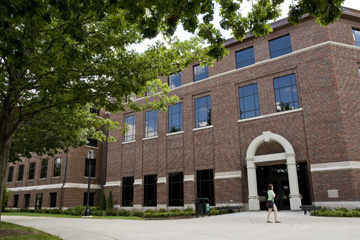Architecture at Purdue
April 23, 2013
 |
|
The 2011 Roger B. Gatewood Wing successfully updated and expanded the Mechanical Engineering Building while blending seamlessly with the original structure. The metal archway, which mimics traditional limestone, alludes to the newness of the wing. (Purdue University photo/Andrew Hancock) |
Though Purdue's campus is evolving, the campus master plan, supported by our architectural guiding principles, maintains the sense of order and unity of the campus.
Gene Hatke, senior architect in physical and capital planning, compiled an overview that discusses Purdue's architectural history and guidelines for future buildings.
"When it comes to architecture, we're typically looking at things well beyond the timeline on which other people think," Hatke says. "We have buildings on campus that are over 100 years old, and we're constructing new ones all the time. They've all got to work together."
One of the greatest efforts in developing Purdue's campus was to create an organized and united identity, which is accomplished by working to use common materials and structural features across campus.
Serving as the primary architecture firm used by Purdue from the 1920s until the 1990s, Lafayette's present-day Scholer Corp. LLC was one of the major contributors in creating the campus identity. The historically traditional features of Purdue buildings are red brick, tiled roof and "punched" windows that align both vertically and horizontally. Accents of limestone frequently trim the doors, windows and other areas of the facade. The Physics and Electrical Engineering buildings best exemplify these features. Though building shapes have changed with University needs and time period preferences, most of campus sports these unifying features.
"Iconic" structures, such as Purdue Memorial Union and the Bell Tower, have visually prominent locations and unique designs that emphasize their historical and functional significance to the University. For example, the towering limestone pillars accenting the entrance of Hovde Hall reference Greek architecture and highlight the building's administrative importance.
Deviating from the traditional practice during times of budgetary constraints or rapidly booming enrollment, buildings like Mathematical Sciences sacrificed height proportions and details to reduce costs and house more people but maintained a brick and limestone exterior. However, others appear to have diverged from the historic appearance; buildings such as Psychological Sciences and Johnson Hall of Nursing show a popular 1960s style that differs from the Purdue materials and design.
Some buildings have successfully incorporated the traditional design features while overcoming challenges. For example, Beering Hall was forced to fit a large program into a small ground footprint. Though seven stories tall, Hatke says the building's height is successfully masked by the more noticeable three-story classroom component.
A nod to the innovative research performed within their walls, the buildings of Discovery Park were designed to appear very different from the rest of campus, and utilize complex building shapes, towering glazed windows and very little brick. Hatke says the effect is then further optimized by its juxtaposition to the highly traditional brick and limestone facade of Hanley Hall, located immediately across State Street from Discovery Park.
Purdue's newer buildings are beginning to show off the progressive nature of the University, while still tying in tradition through materials. For example, buildings planned to incorporate more retail space have large ground-level windows to allow street visibility. Wang Hall and Vawter Field Housing will both house retail areas once constructed.
Hatke says new buildings are designed by considering the location, surrounding structures and purpose.
"Every building is unique, and no design comes easily," he says. "But in the end it's about looking at campus and not individual buildings."
"Architecture on Campus," the general review of architecture history at Purdue and future plans for campus buildings, can be found at www.purdue.edu/pandcp/docs/Architecture-On-Campus.pdf.
A photo gallery of campus architecture is available here.
If you can not read the pdf documents on this page, please download Adobe Acrobat.

